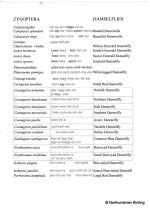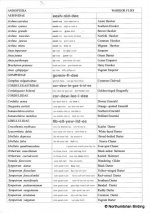Scientific, BDS Name, Dijkstra Name
Calopteryx splendens, Banded Demoiselle, Banded Demoiselle
Calopteryx virgo, Beautiful Demoiselle, Beautiful Demoiselle
Lestes sponsa, Emerald Damselfly, Common Spreadwing
Lestes dryas, Scarce Emerald Damselfly, Robust Spreadwing
Lestes barbarus, Southern Emerald Damselfly, Migrant Spreadwing
Lestes viridis, Willow Emerald Damselfly, Western Willow Spreadwing
Sympecma fusca, Winter Damselfly, Common Winter Damsel
Ischnura elegans, Blue-tailed Damselfly, Common Bluetail
Ischnura pumilio, Scarce Blue-tailed Damselfly, Small Bluetail
Enallagma cyathigerum, Common Blue Damselfly, Common Bluet
Coenagrion pulchellum, Variable Damselfly, Variable Bluet
Coenagrion puella, Azure Damselfly, Azure Bluet
Coenagrion mercuriale, Southern Damselfly, Mercury Bluet
Coenagrion scitulum, Dainty Damselfly, Dainty Bluet
Coenagrion hastulatum, Northern Damselfly, Spearhead Bluet
Coenagrion lunulatum, Irish Damselfly, Crescent Bluet
Coenagrion armatum, Norfolk Damselfly, Dark Bluet
Erythromma najas, Red-eyed Damselfly, Large Redeye
Erythromma viridulum, Small Red-eyed Damselfly, Small Redeye
Pyrrhosoma nymphula, Large Red Damselfly, Large Red Damsel
Ceriagrion tenellum, Small Red Damselfly, Small Red Damsel
Platycnemis pennipes, White-legged Damselfly, Blue Featherleg
Aeshna mixta, Migrant Hawker, Migrant Hawker
Aeshna affinis, Southern Migrant Hawker, Blue-eyed Hawker
Aeshna isoceles, Norfolk Hawker, Green-eyed Hawker
Aeshna grandis, Brown Hawker, Brown Hawker
Aeshna caerulea, Azure Hawker, Azure Hawker
Aeshna juncea, Common Hawker, Moorland Hawker
Anax imperator, Emperor Dragonfly, Blue Emperor
Anax junius, Green Darner, Common Green Darner
Anax parthenope, Lesser Emperor, Lesser Emperor
Hemianax ephippiger, Vagrant Emperor, Vagrant Emperor
Brachytron pratense, Hairy Dragonfly, Hairy Hawker
Gomphus vulgatissimus, Common Club-tail, Common Clubtail
Cordulegaster boltonii, Golden-ringed Dragonfly, Common Goldenring
Cordulia aenea, Downy Emerald, Downy Emerald
Somatochlora metallica, Brilliant Emerald, Brilliant Emerald
Somatochlora arctica, Northern Emerald, Northern Emerald
Oxygastra curtisii, Orange-spotted Emerald, Orange-spotted Emerald
Libellula quadrimaculata, Four-spotted Chaser, Four-spotted Chaser
Libellula depressa, Broad-bodied Chaser, Broad-bodied Chaser
Libellula fulva, Scarce Chaser, Blue Chaser
Orthetrum cancellatum, Black-tailed Skimmer, Black-tailed Skimmer
Orthetrum coerulescens, Keeled Skimmer, Keeled Skimmer
Leucorrhinia dubia, White-faced Darter, Small Whiteface
Leucorrhinia pectoralis, Large White-faced Darter, Yellow-spotted Whiteface
Sympetrum danae, Black Darter, Black Darter
Sympetrum pedemontanum, Banded Darter, Banded Darter
Sympetrum sanguineum, Ruddy Darter, Ruddy Darter
Sympetrum flaveolum, Yellow-winged Darter, Yellow-winged Darter
Sympetrum fonscolombii, Red-veined Darter, Red-veined Darter
Sympetrum striolatum, Common Darter, Common Darter
Sympetrum vulgatum, Vagrant Darter, Moustached Darter
Crocothemis erythraea, Scarlet Darter, Broad Scarlet
Pantala flavescens, Wandering Glider, Wandering Glider





